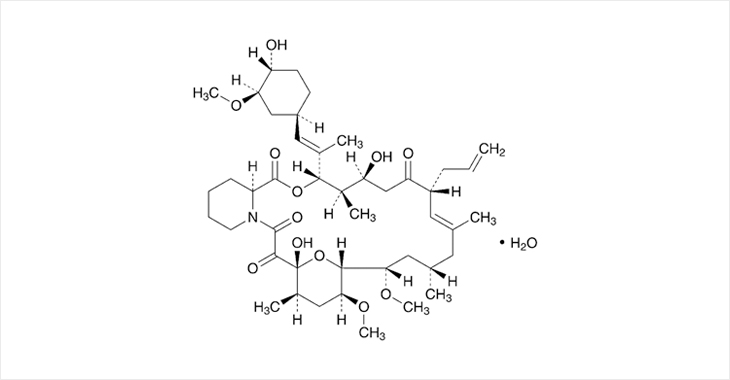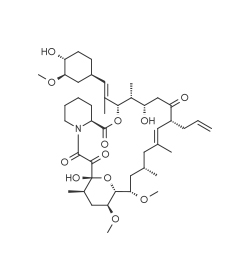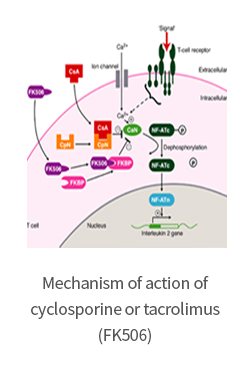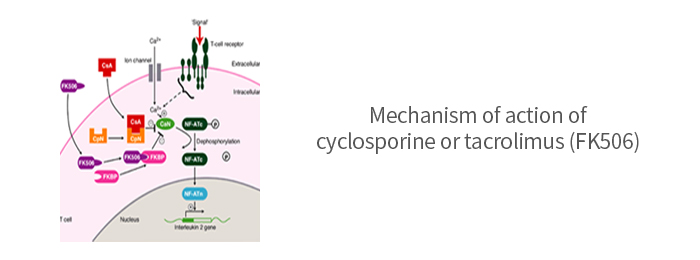Tacrolimus Hydrate (Immunosuppressant)


C44H69NO12·H2O
- Tacrolimus is a polyketide macrolide lactone with immunosuppressive activity. It is primarily used to reduce the risk of organ rejection in patients with allogeneic organ transplantation. It is also used to treat autoimmune diseases, such as atopic dermatitis.
- Tacrolimus is a highly potent immunosuppressant. Compared to a similar immunosuppressant cyclosporine, tacrolimus has been shown to be 10 to 100 times more potent and have less side effects, such as hypertension, hirsutism and gingivalhyperplasia.
- Since 2003, Ceres F&D has researched industrial technologies for microbial bioactive substances biological active substance to develop high-production fermentations strains for industrial production of tacrolimus (patent no. 2007-0082624), high-purity processes suitable for pharmaceutical standards (patent no. 2008-00915, 2008-0091521), genetic biosynthesis of tacrolimus (patent no. 2008-00118854), and analysis methods of tacrolimus and its related substances. Based on these patented technologies, in 2009, we registered and scaled up from lab scale to plant scale for commercial production of tacrolimus.


Tacrolimus (FK506)
- Production Strain : Streptomyces tsukubaensis
- Structure: Polyketide macrolide lactone ※Chemical synthesis not possible
- Properties : White non-crystalline powder.Low water solubility (4㎍/㎖).
- Patents : Major patent expired in 2008
- Development History : First developed by Fujisawa Co. Ltd in Japan in 1984.


Mechanism of Action (Calcineurin Inhibitor)
Tacrolimus, also known as FK506,binds to the binding protein FKBP, and this complex inhibits the activity of calcineurin. By inhibiting the dephosphorylation of NF-AT by calcineurin, the downstream transcription of interleukin 2 genes, TNF-α, and proto-oncogenes is blocked. Thus, tacrolimus causes a powerful inhibitory effect on T-lymphocyte activation.
Indicated Uses
- Organ transplantation patient immunotherapy
- Orally, as a insoluble capsule
- Long-term treatment to reduce rejection with organ transplantation
- For severe atopic dermatitis, as an ointment?
Our Tacrolimus Patents & Technologies
| Patent Number | Title | Characteristics |
|---|---|---|
| WO2011068341A2 | * Gene and protein for biosynthesis of tricyclocompounds | Available for produce highly Tacrolimus made from genetic recombinant |
| US8193345 B2 | ** Purification method of lactone compounds containing unsaturated alkyl group by extraction with silver ion solution | Ensured incomparable impurities purification technology (Maximize purification recovery) |
| WO2013022238 | *** Tricyclic glycosylated derivative compound, a production method therefor, and an immunosuppressant pharmaceutical composition comprising a tacrolimus glycosylation derivative | Novel compound overcome physical formulation stability (emulsion, etc) |
- *As genetically engineered approach to Actinomycetes, it is possible for mass production of high concentration Tacrolimus.
- **Reducing production costs by removing of impurities such as FK520, DH-tacro, FK525 and reusing of sliver ion
- ***From continuous chemical bonds with mono-, di-, tri-saccharide, it makes various formulation by 1000 fold increased hydrophilicity. Also, introducing candidate substance for modified drug using additional indicant.
CERTIFICATE OF ANALYSIS
Product Name : Tacrolimus Hydrate(IP/JP/USP/Ph.Eur)| Test | Specification | |
|---|---|---|
| Description | A white crystal or white crystalline powder | |
| Solubility | Very soluble in methanol and ethanol, Freely soluble in N,N-dimethylformamide, Soluble in ethyl acetate, Sparingly soluble in hexane, In soluble in water and heptane | |
| Identification | IR | The IR spectrum of sample should be concordant with that of standard |
| HPLC | The retention time of the major peak of the Sample solution corresponds to that of the Standard solution as obtained in the Assay | |
| Color | Red-purple color develops | |
| Optical Rotation | -110 to -115 | |
| Appearance of solution | 1. The solution is clear and not more intensely colored than reference solution GY7 | |
| 2. Dissolve 0.2g in ethanol and dilute to 20 ml with same solvent | ||
| Water content | NMT 4.0% | |
| Residue on ignition | NMT 0.1% | |
| Organic impurities, Procedure 1 | Tacrolimus methylacryl aldehyde | NMT 0.2% |
| Tacrolimus diene | NMT 0.2% | |
| Any individual unspecified impurity | NMT 0.2% | |
| Total impurities | NMT 0.3% | |
| Organic impurities, Procedure 2 | Ascomycin 19-epimer | NMT 0.1% |
| Ascomycin | NMT 0.5% | |
| Desmethyl tacrolimus (if present) | NMT 0.1% | |
| Tacrolimus 8-epimer | NMT 0.15% | |
| Tacrolimus 8-propyl analog | NMT 0.15% | |
| Any individual unspecified impurity | NMT 0.1% | |
| Total impurities | NMT 1.0% | |
| Residual Solvent | Hexane | NMT 290 ppm |
| Acetone | NMT 5,000 ppm | |
| Ethylacetate | NMT 5,000 ppm | |
| Heptane | NMT 5,000 ppm | |
| Assay (by HPLC, on anhydrous and solvent free basis) | 98.0 to 102.0% | |
| Storage: Store protected from moisture and at a controlled temperature below 30℃ | ||
| This is USP version. Specification will be changed for IP/JP/Ph.Eur | ||
